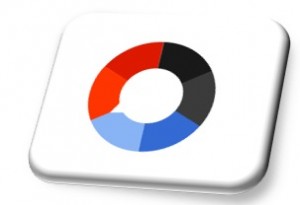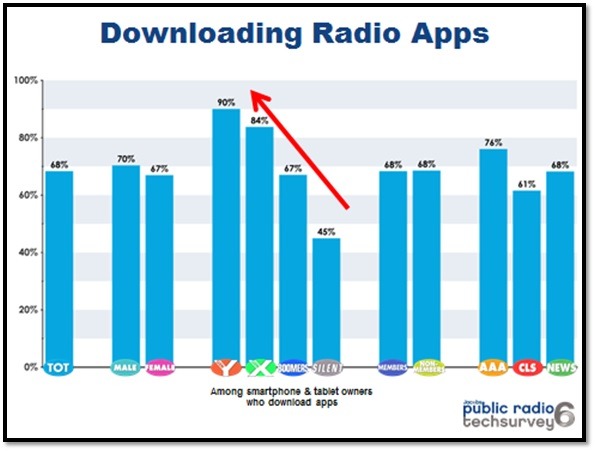The Best of JacoBLOG continues on the day after Christmas with some of our best efforts from 2014. This past August, we took the opportunity to review the NPR One app, a revolutionary content and delivery mechanism for both national and local public radio. In the process, there’s a lot to think about here in terms of time-shifting and podcasting – elements that NPR knows a lot about. We know that podcasting is going to be an even bigger topic in 2015, so let’s get the juices flowing while it’s nice and quiet around the house, and Brenda Lee and Burl Ives are getting a much-needed rest. – FJ
It’s always breathtaking when a megawatt brand has that realization that there’s an even greater opportunity beyond their core product – and has the (schweddy) cojones to act on it.
We’ve seen Apple do this several times. They disrupted the iPod with the iPhone and then disrupted the iPhone with the iPad. And it’s worked out pretty well for them.
But in traditional media circles, radio and TV companies have tended to be more cautious in actively pursuing potentially disruptive options, even thou they could build more brand equity, increased loyalty, and more usage. But, of course, there’s risk involved. As a result, streaming, customized channels, podcasts, on-demand programming, and other innovations have often first come from outside predators before broadcasters got the memo and scrambled to keep up.
So the “soft launch” of NPR One is worthy of your attention. For some time now, NPR has talked about their version of a Pandora-like app for their impressive content – a way for users to enjoy the public radio experience but in a customized, curated, and yes, algorithmic way. In fact, it was just about a year ago when former NPR CEO Gary Knell referred to his network’s efforts in this area as creating “a Pandora for news.”
And of course, timing is everything. Earlier this week, Pandora pointed to the appeal of spoken word programming – especially in “connected cars” – to let the world know that it is taking a hard look at talk programming for those behind the wheel. But it’s one thing for Pandora to brand extend from music into spoken word. It’s a whole other initiative when NPR offers its content to consumers in an on-demand, Pandora-like way.
NPR One is still working out the bugs, but you can already see where it’s headed. After you register to gain access to the app, it starts you out with a newscast, and then immediately hooks you up with a local programming feature from a nearly public radio station (which you can adjust).
This effort to localize its digital network programming offering speaks to the balancing act that is taking place within NPR’s effort to provide unique digital/mobile touch points, give consumers an opportunity to customize their programming, and to also be mindful of the importance of the local programming provided by its affiliates.
Not everyone in the public radio system is going to be thrilled by NPR One – that’s just not possible. But it is a strong mobile effort, and like NPR’s iPad app that was timed to launch when Steve Jobs unveiled tablets to the world, it is a bold move.
Not surprisingly, NPR One allows the user to rewind, skip, and pause. And you can let the algorithm know that you find a segment “interesting.” But this initiative goes well beyond just providing an app that acts as a public radio hub that you can personalize.
Like other media brands, NPR (and all of public radio) is grappling with the reality that there are different generations – and mindsets – that utilize and consume its programming. Keeping the established audience happy and engaged – mostly Baby Boomers – is an art that public radio programmers have perfected for decades. The harder part is catering to Generations X and Y at the same time, and making it all work.
You can see that loud and clear in our recently completed Public Radio Techsurvey6 that we conducted in partnership with Arthur Cohen and his Public Radio Program Directors Association. By generation, there is a marked difference in appreciation and usage of radio-centric mobile apps. NPR has always had its eye on the mobile revolution, and this app speaks to the challenges and opportunities represented by the younger generations. As public radio has led the audio field in podcasts, it now has designs on affecting the mobile app space with similar impact.
Public radio has expanded its reach since the beginning of this millennium, and continues to be an extremely highly regarded brand. At the recent PMDMC conference in Denver, incoming CEO Jarl Mohn reminded attendees that while NPR is a “powerful” brand, it should be leveraged to help brand local stations.
That seems to be where NPR is headed but it’s never simple keeping all the plates spinning happily at the same time. And the public radio world is watching closely. Tim Eby is the General Manager of St. Louis Public Radio and wrote a blog post – aptly called “Disrupting Ourselves” – during the first week of NPR One’s launch.
In it, he discusses some of the app’s issues that impact the entire public radio system – local and network – including on-air pledge drives, data gathering and metrics, content and workflow issues, and of course, staffing questions.
You can bet there will be lively discussions in the public radio community as this mobile app begins to make its way through the public radio system and through the two biggest app stores to consumers.
NPR One is a bold effort. You might even call it innovative.
- Media And Technology In 2025: Believe It Or Not! - April 18, 2025
- In Radio, You Just Never Know - April 17, 2025
- The Secret To Making A Great Podcast (And Great Radio) - April 16, 2025






Leave a Reply